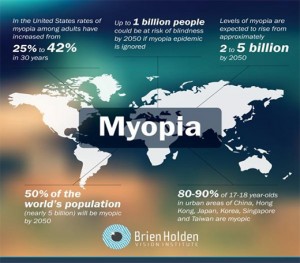Optometric press
- 5 billion myopes by the year 2050; up from 1.4 billion in 2000
- 1 billion high myopes by 2050; a five-fold increase from 2000
- Number with vision loss from high myopia to increase seven-fold from 2000 to 2050; myopia to become a leading cause of permanent blindness worldwide.
General health, government and non-optometric NGOs
- 5 billion to be short-sighted (myopic) by the year 2050
- One in ten at risk of blindness by 2050
- Myopia to become a leading cause of permanent blindness worldwide
- Parents urged to get children’s eyes checked regularly, get them outdoors and moderate time using electronic devices
Statistics from paper
Data from ‘Global Prevalence of Myopia and High Myopia and Temporal Trends from 2000 through 2050’, published online on 11 February 2016 at:http://www.sciencedirect.com/science/article/pii/S0161642016000257
Global
- Number of myopes – 1.4 billion (2000) up to 5 billion (2050)
- Number of high myopes – 163 million (2000) up to 1 billion (2050)
- Number of myopes between 5 and 19 years of age – 20% (2000) up to 31% (2050)
North America (U.S. & Canada)
- Number of myopes – 90 million (2000) up to 260 million (2050)
- Number of high myopes – 11 million (2000) up to 66 million (2050)
Australasia (Australian & New Zealand)
- Number of myopes – 5 million (2000) up to 22 million (2050)
- Number of high myopes – 547,000 (2000) up to 4 million (2050)
East Asia (China, Hong Kong SAR (China), Macau SAR (China), Democratic People’s Republic of Korea, Taiwan)
- Number of myopes – 517 million (2000) up to 941 million (2050)
- Number of high myopes – 74 million (2000) up to 305 million (2050)
South Asia (Afghanistan, Bangladesh, Bhutan, India, Nepal, Pakistan)
- Number of myopes – 196 million (2000) up to 1,160 million (2050)
- Number of high myopes – 25 million (2000) up to 233 million (2050)
Asia-Pacific, high income (Brunei Darussalam, Japan, Republic of Korea, Singapore)
- Number of myopes – 81 million (2000) up to 110 million (2050)
- Number of high myopes – 11 million (2000) up to 37 million (2050)
South East Asia (Cambodia, Indonesia, Lao People’s Democratic Republic, Malaysia, Maldives, Myanmar, Philippines, Sri Lanka, Thailand, Timor-Leste, Vietnam)
- Number of myopes – 182 million (2000) up to 500 million (2050)
- Number of high myopes – 8 million (2000) up to 75 million (2050)
Western Europe (Andorra, Austria, Belgium, Cyprus, Denmark, Finland, France, Germany, Greece, Iceland, Ireland, Israel, Italy, Luxembourg, Malta, Netherlands, Norway, Portugal, Spain, Sweden, Switzerland, United Kingdom)
- Number of myopes – 87 million (2000) up to 252 million (2050)
- Number of high myopes – 9 million (2000) up to 43 million (2050)
- Prevalence of myopia in 5 to 19 year olds – 22% (2000) up to 47% (2050)
Latin America Central (Colombia, Costa Rica, El Salvador, Guatemala, Honduras, Mexico, Nicaragua, Panama, Venezuela (Bolivarian Republic of))
- Number of myopes – 45 million (2000) up to 183 million (2050)
- Number of high myopes – 4 million (2000) up to 24 million (2050)
North Africa & Middle East (Algeria, Bahrain, Egypt, Iran (Islamic Republic of), Iraq, Jordan, Kuwait, Lebanon, Libyan Arab Jamahiriya, Morocco, Occupied Palestinian Territory, Oman, Qatar, Saudi Arabia, Syrian Arab Republic, Tunisia, Turkey, United Arab Emirates, Yemen)
- Number of myopes – 54 million (2000) up to 357 million (2050)
- Number of high myopes – 4 million (2000) up to 38 million (2050)
Myopia FAQs in plain English
What is myopia?
Myopia, also known as ‘short-sightedness’ or ‘near-sightedness’, causes people to have difficulty seeing distant objects clearly.
What causes myopia?
The causes of myopia are both genetic and environmental. It is suggested that increased urbanisation and close-range activities e.g. reading and computer work, are increasing the incidence of myopia.
Who does it affect?
Myopia usually begins in childhood at school age (six years and onwards) and can worsen until early adult years. This is referred to as youth-onset or juvenile-onset myopia. It can also occur in adults (ages 20 to 40) with no prior history of problems in childhood, termed early adult-onset myopia. One can also be born with high levels of myopia (congenital myopia).
If myopia is untreated, what can happen?
Growing levels of high myopia are increasing the risks of serious eye conditions, such as myopic macular degeneration, cataract, glaucoma and retinal detachment, many of which may lead to permanent blindness.
Myopia stats









